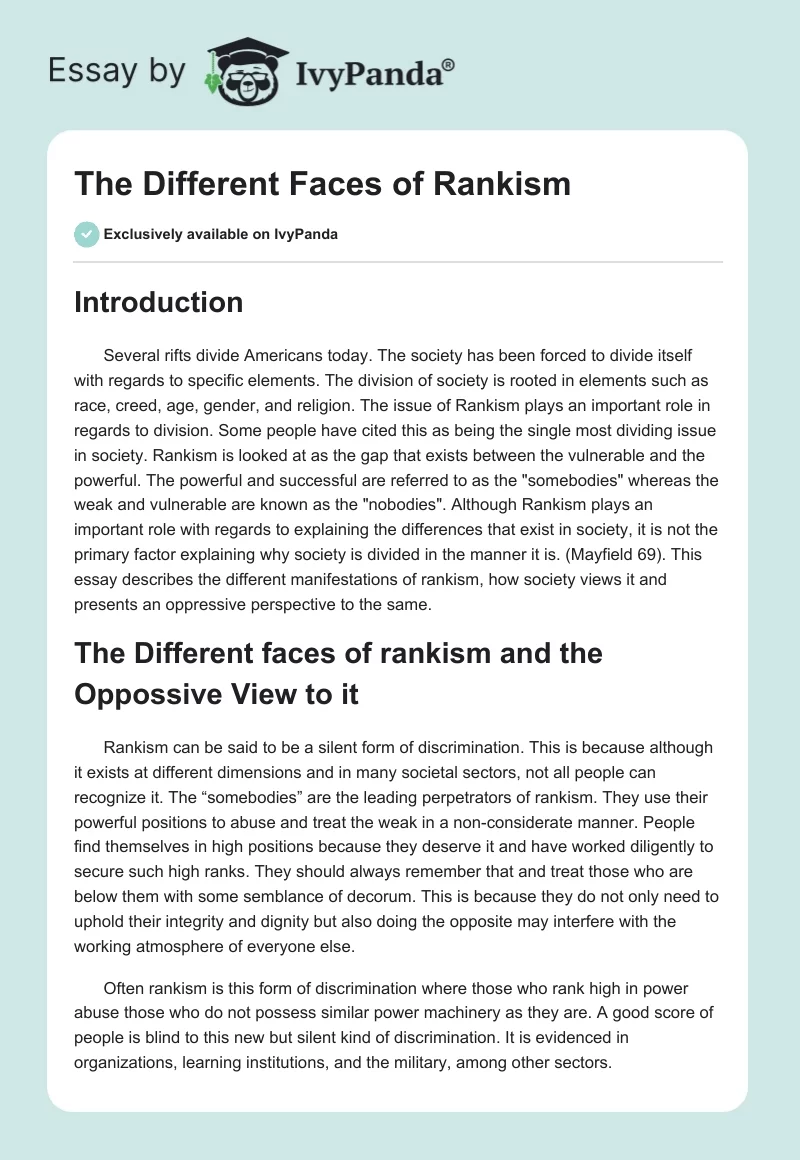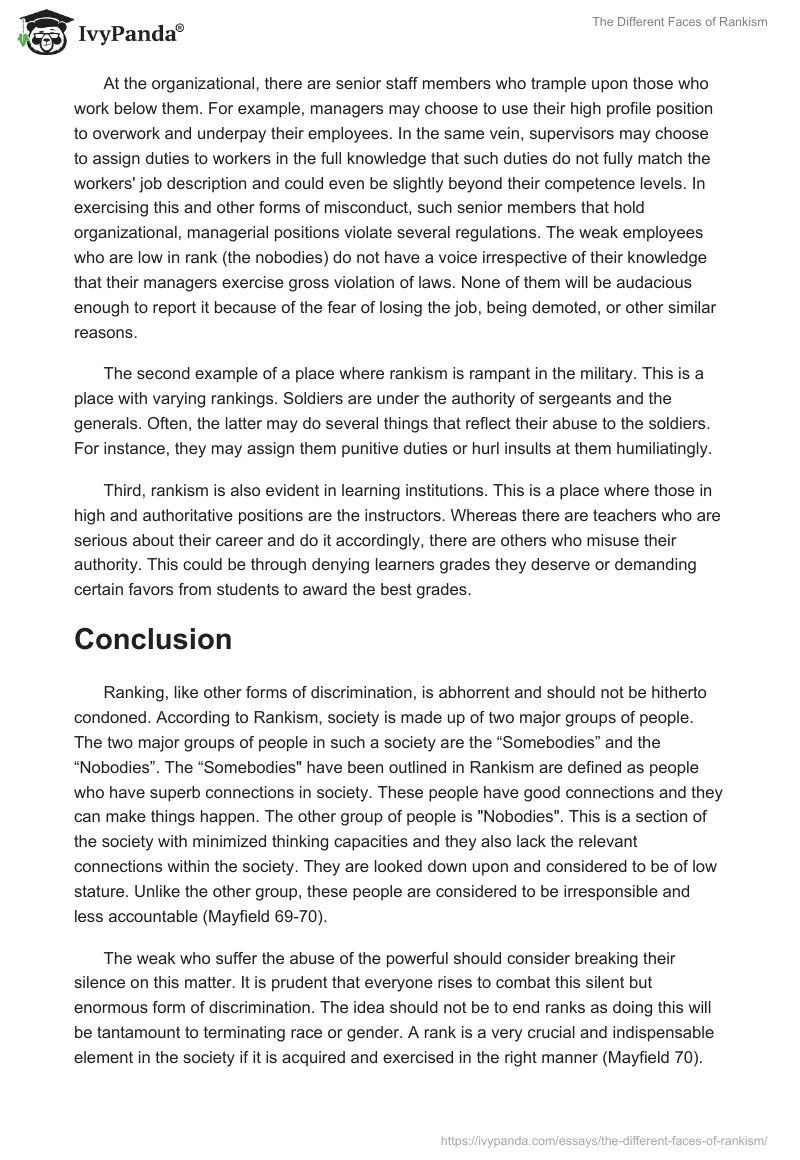Introduction
Several rifts divide Americans today. The society has been forced to divide itself with regards to specific elements. The division of society is rooted in elements such as race, creed, age, gender, and religion. The issue of Rankism plays an important role in regards to division. Some people have cited this as being the single most dividing issue in society. Rankism is looked at as the gap that exists between the vulnerable and the powerful. The powerful and successful are referred to as the “somebodies” whereas the weak and vulnerable are known as the “nobodies”. Although Rankism plays an important role with regards to explaining the differences that exist in society, it is not the primary factor explaining why society is divided in the manner it is. (Mayfield 69). This essay describes the different manifestations of rankism, how society views it and presents an oppressive perspective to the same.
The Different faces of rankism and the Oppossive View to it
Rankism can be said to be a silent form of discrimination. This is because although it exists at different dimensions and in many societal sectors, not all people can recognize it. The “somebodies” are the leading perpetrators of rankism. They use their powerful positions to abuse and treat the weak in a non-considerate manner. People find themselves in high positions because they deserve it and have worked diligently to secure such high ranks. They should always remember that and treat those who are below them with some semblance of decorum. This is because they do not only need to uphold their integrity and dignity but also doing the opposite may interfere with the working atmosphere of everyone else.
Often rankism is this form of discrimination where those who rank high in power abuse those who do not possess similar power machinery as they are. A good score of people is blind to this new but silent kind of discrimination. It is evidenced in organizations, learning institutions, and the military, among other sectors.
At the organizational, there are senior staff members who trample upon those who work below them. For example, managers may choose to use their high profile position to overwork and underpay their employees. In the same vein, supervisors may choose to assign duties to workers in the full knowledge that such duties do not fully match the workers’ job description and could even be slightly beyond their competence levels. In exercising this and other forms of misconduct, such senior members that hold organizational, managerial positions violate several regulations. The weak employees who are low in rank (the nobodies) do not have a voice irrespective of their knowledge that their managers exercise gross violation of laws. None of them will be audacious enough to report it because of the fear of losing the job, being demoted, or other similar reasons.
The second example of a place where rankism is rampant in the military. This is a place with varying rankings. Soldiers are under the authority of sergeants and the generals. Often, the latter may do several things that reflect their abuse to the soldiers. For instance, they may assign them punitive duties or hurl insults at them humiliatingly.
Third, rankism is also evident in learning institutions. This is a place where those in high and authoritative positions are the instructors. Whereas there are teachers who are serious about their career and do it accordingly, there are others who misuse their authority. This could be through denying learners grades they deserve or demanding certain favors from students to award the best grades.
Conclusion
Ranking, like other forms of discrimination, is abhorrent and should not be hitherto condoned. According to Rankism, society is made up of two major groups of people. The two major groups of people in such a society are the “Somebodies” and the “Nobodies”. The “Somebodies” have been outlined in Rankism are defined as people who have superb connections in society. These people have good connections and they can make things happen. The other group of people is “Nobodies”. This is a section of the society with minimized thinking capacities and they also lack the relevant connections within the society. They are looked down upon and considered to be of low stature. Unlike the other group, these people are considered to be irresponsible and less accountable (Mayfield 69-70).
The weak who suffer the abuse of the powerful should consider breaking their silence on this matter. It is prudent that everyone rises to combat this silent but enormous form of discrimination. The idea should not be to end ranks as doing this will be tantamount to terminating race or gender. A rank is a very crucial and indispensable element in the society if it is acquired and exercised in the right manner (Mayfield 70).
A person’s rank or social-economic status should not cause them to take advantage of others. The healthcare, education, the military, and learning institutions should be restructured to reflect everybody’s dignity (Witt 144). Everybody should rise and fight rankism. The weak and less powerful should dare report the strong and mighty that may take advantage of the latter’s weakness. Those in high ranks should regard such positions as opportunities to serve rather than a reason to trample down and abuse others. Taking such measures will make society a better place to live for everyone.
Works Cited
Mayfield, Marlys. Thinking for yourself. 8th. Boston, Massachusetts: Wadsworth Publishing Company, 2010. Print.
Watt, Matt, Out of the Mainstream: Books and Films You May Have Missed: Ebscohost, 1(1): 144-147. Print.


